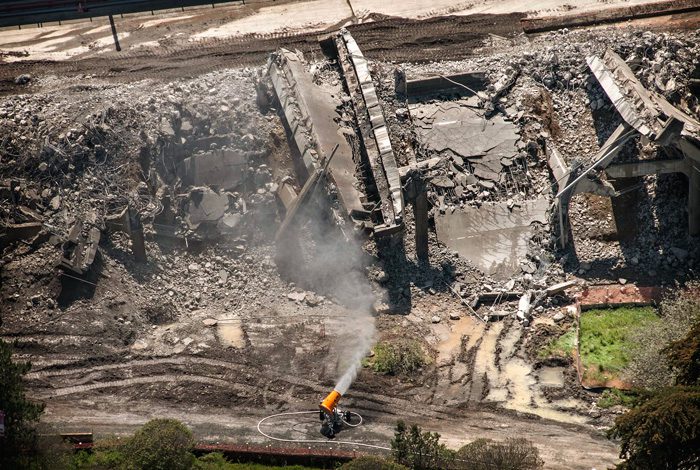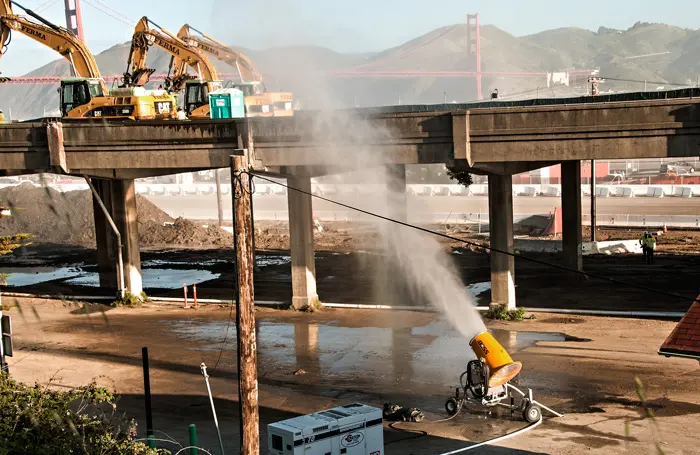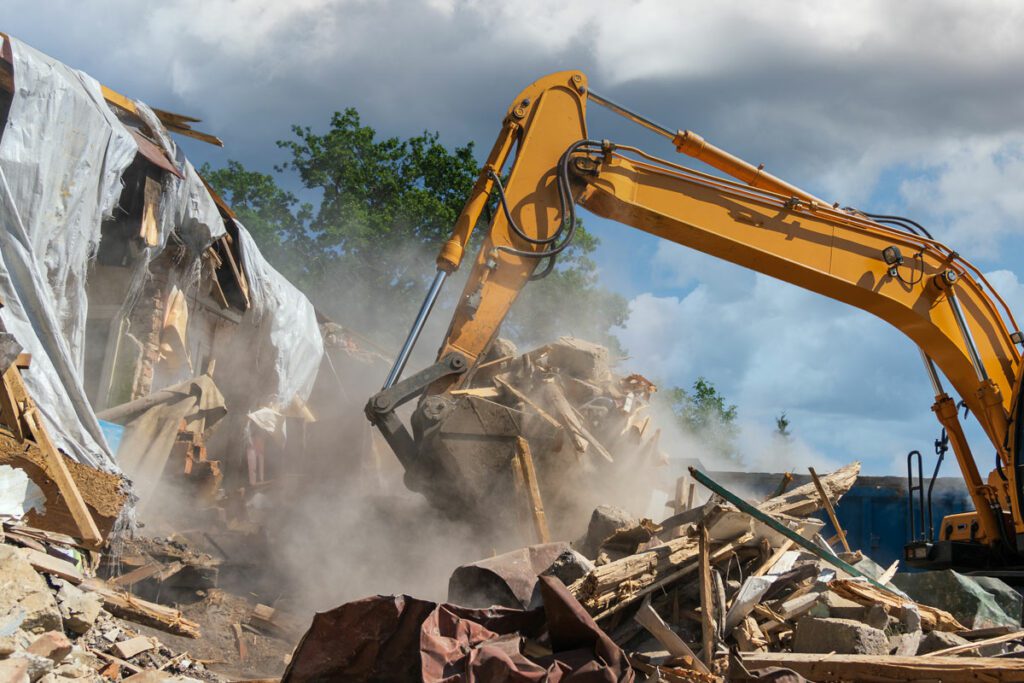Crews had one weekend to demolish the main route to the Golden Gate Bridge. And dust control was a top priority.
The California Department of Transportation's take down of the Doyle Drive parkway followed a complex plan that included a network of DustBoss® atomized misting units to form an effective barrier and prevent particle migration along the entire length of the deconstructed roadway.
Originally constructed in 1936, Doyle Drive is a busy thoroughfare that carries thousands of cars per hour in peak traffic periods. Determined to be nearing the end of its useful service life, replacing it will be an entirely new Presidio Parkway design, including two tunnels, a wide landscaped median and engineered transitions to city streets to ease traffic and improve safety.
“This was a very high-profile job.
Our goal was to take all practical measures, using the best technology available, to mitigate the demolition dust and protect people, property and the environment."
-Andrew Yan
Engineer
Demolition of the old roadway involved approximately 4,700 linear feet of roadway, including some 150 spans in three distinct structures. Yet the plan required that the road be completely closed for just one weekend to demolish the whole section.
“There was only a 57-hour window to demolish the existing structure and complete construction of the bypass before we had to reopen the roadway to vehicle traffic,” said California DOT Resident Engineer Andrew Yan. “It was a tall order, but we planned out every detail.”
The process required a fleet of 40 pieces of demolition equipment, including 20 hydraulic excavators outfitted with a variety of work tools, such as hammers, grapples, pulverizers and shears. Crews also used backhoe loaders, track loaders, wheeled loaders and articulated dump trucks, all running continuously to meet the tight deadline.
Critical Dust Particle Containment
Because of its proximity to the Presidio, an historic national park that remained open to the public during demolition, the contract called for a dust control plan to prevent all visible dust from leaving the project boundaries while work was underway.
“In some places, the public areas were less than 100 feet away from the demolition activity,” Yan said. “There’s also a residential neighborhood and business corridor adjacent to Doyle Drive. We had to consider the nearby marsh, wetlands and forest, as well as the wildlife within those habitats.”
With dust suppression such a high priority, CalTrans researched a number of equipment options to supplement traditional water trucks and manual spraying.
“Because we had simultaneous demolition in four distinct locations on this project, we needed dust control over a very wide area,” he said. “But the manpower we could commit to that was limited.”
Yan remembered that engineers on a previous CalTrans project on the Oakland Bay Bridge had successfully controlled the demolition dust on that job with large atomized misting units.
After reviewing specifications on the various models, he arranged a rental of eight DustBoss DB-60s with onsite training.
Dust Suppression by Design
The DB-60 is a large-scale suppression unit with special atomizing nozzles that create an “engineered mist,” sizing the droplets specifically for optimum dust control (typically 50-200 microns).
A powerful 25 HP fan launches the plume over long distances, allowing one full-oscillation machine to cover nearly 125,000 square feet (more than 11,600 square meters) with a highly efficient dust-trapping mist.
The DB-60 represents one of the few suppression technologies that’s effective on both ground level dust and airborne particles. Like all of the company’s fan-based atomizers, the DB-60 delivers its power and reliability by using a direct-drive fan motor.
It has no drive belts, diesel engines or complex gear systems that could present reliability problems in the difficult service environment of a demolition site, coal mine or recycling yard.
Mandatory Dust Management
In California DOT work sites, dust control is no longer a luxury but a contractually-mandated component of demolition, construction,and certain types of maintenance work, subject to inspection.
“Dust suppression strategies and techniques are constantly being reviewed and refined,” Yan said.
“I was particularly impressed by the range of the units and the relatively low noise level during operation,” he said. “The ability to easily mobilize and relocate them as needed was also a big advantage.”
“This was a very high-profile job,” Yan added. “Our goal was to take all practical measures, using the best technology available, to mitigate the demolition dust and protect people, property and the environment. I would recommend the DustBoss on future contracts of this type.”
CUSTOMER
California Department of Transportation
LOCATION
San Francisco, CA (USA)
CHALLENGE
Prevent all visible dust from leaving project boundaries during demolition of nearly a mile of raised roadway, including 150 spans, all to be accomplished in one weekend.
SOLUTION
Eight DustBoss® 60s (DB-60s)
RESULTS
The fleet of rented units delivered effective dust management on this very high-profile job, contributing to a healthier workplace on the complex project, while protecting the surrounding
communities and natural environment.
Crews had one weekend to demolish the main route to the Golden Gate Bridge. And dust control was a top priority.
The California Department of Transportation's take down of the Doyle Drive parkway followed a complex plan that included a network of DustBoss® atomized misting units to form an effective barrier and prevent particle migration along the entire length of the deconstructed roadway.
Originally constructed in 1936, Doyle Drive is a busy thoroughfare that carries thousands of cars per hour in peak traffic periods. Determined to be nearing the end of its useful service life, replacing it will be an entirely new Presidio Parkway design, including two tunnels, a wide landscaped median and engineered transitions to city streets to ease traffic and improve safety.
“This was a very high-profile job.
Our goal was to take all practical measures, using the best technology available, to mitigate the demolition dust and protect people, property and the environment."
-Andrew Yan
Engineer
Demolition of the old roadway involved approximately 4,700 linear feet of roadway, including some 150 spans in three distinct structures. Yet the plan required that the road be completely closed for just one weekend to demolish the whole section.
“There was only a 57-hour window to demolish the existing structure and complete construction of the bypass before we had to reopen the roadway to vehicle traffic,” said California DOT Resident Engineer Andrew Yan. “It was a tall order, but we planned out every detail.”
The process required a fleet of 40 pieces of demolition equipment, including 20 hydraulic excavators outfitted with a variety of work tools, such as hammers, grapples, pulverizers and shears. Crews also used backhoe loaders, track loaders, wheeled loaders and articulated dump trucks, all running continuously to meet the tight deadline.
Critical Dust Particle Containment
Because of its proximity to the Presidio, an historic national park that remained open to the public during demolition, the contract called for a dust control plan to prevent all visible dust from leaving the project boundaries while work was underway.
“In some places, the public areas were less than 100 feet away from the demolition activity,” Yan said. “There’s also a residential neighborhood and business corridor adjacent to Doyle Drive. We had to consider the nearby marsh, wetlands and forest, as well as the wildlife within those habitats.”
With dust suppression such a high priority, CalTrans researched a number of equipment options to supplement traditional water trucks and manual spraying.
“Because we had simultaneous demolition in four distinct locations on this project, we needed dust control over a very wide area,” he said. “But the manpower we could commit to that was limited.”
Yan remembered that engineers on a previous CalTrans project on the Oakland Bay Bridge had successfully controlled the demolition dust on that job with large atomized misting units.
After reviewing specifications on the various models, he arranged a rental of eight DustBoss DB-60s with onsite training.
Dust Suppression by Design
The DB-60 is a large-scale suppression unit with special atomizing nozzles that create an “engineered mist,” sizing the droplets specifically for optimum dust control (typically 50-200 microns).
A powerful 25 HP fan launches the plume over long distances, allowing one full-oscillation machine to cover nearly 125,000 square feet (more than 11,600 square meters) with a highly efficient dust-trapping mist.
The DB-60 represents one of the few suppression technologies that’s effective on both ground level dust and airborne particles. Like all of the company’s fan-based atomizers, the DB-60 delivers its power and reliability by using a direct-drive fan motor.
It has no drive belts, diesel engines or complex gear systems that could present reliability problems in the difficult service environment of a demolition site, coal mine or recycling yard.
Mandatory Dust Management
In California DOT work sites, dust control is no longer a luxury but a contractually-mandated component of demolition, construction,and certain types of maintenance work, subject to inspection.
“Dust suppression strategies and techniques are constantly being reviewed and refined,” Yan said.
“I was particularly impressed by the range of the units and the relatively low noise level during operation,” he said. “The ability to easily mobilize and relocate them as needed was also a big advantage.”
“This was a very high-profile job,” Yan added. “Our goal was to take all practical measures, using the best technology available, to mitigate the demolition dust and protect people, property and the environment. I would recommend the DustBoss on future contracts of this type.”
Implement Dust Control at Your Jobsite!
Receive a FREE quote and talk to a dust control specialist today to stop fugitive dust!
Get A Quote
More BossTek
Subscribe and Stay Up-to-Date!
Receive a monthly newsletter keeping you up-to-date on the latest in dust and odor control.
Subscribe







